Introduction
Understanding the intricacies of right-of-way is essential for landowners and stakeholders involved in land acquisition. This legal concept grants one party the right to pass through or use another's property, playing a significant role in the development of infrastructure projects such as roads, utilities, and pipelines. The City of Fort Worth's frequent use of eminent domain to expedite essential projects like the Lake Arlington Lift Station underscores the practical implications of right-of-way laws.
The value of land dedicated to roadways alone, estimated at $5.4 trillion, highlights the substantial impact these rights have on urban development. Additionally, the protests by the Standing Rock Sioux Tribe against the Dakota Access Pipeline demonstrate how right-of-way laws affect communities with deep historical ties to their land. Understanding right-of-way is crucial not only for protecting property rights but also for recognizing its broader societal and economic impacts.
Understanding Right-of-Way
Right-of-way pertains to the legal entitlement of one party to traverse or utilize the land of another. This concept is particularly important in the context of property acquisition, where it pertains to easements or areas granted for utility installations, roads, or other infrastructure projects. For instance, the City of Fort Worth has used eminent domain six times since 2020 to facilitate the Lake Arlington Lift Station project, highlighting the practical implications of right-of-way laws. Grasping this idea is essential for property owners as it not only impacts their ownership rights but also the possible utilization of their property. The worth of terrain utilized for roadways alone is estimated at $5.4 trillion today, showcasing the significant impact these rights can have on urban development. Moreover, as seen in the Standing Rock Sioux Tribe’s protests against the Dakota Access Pipeline, right-of-way laws can profoundly affect communities with deep historical ties to their land.
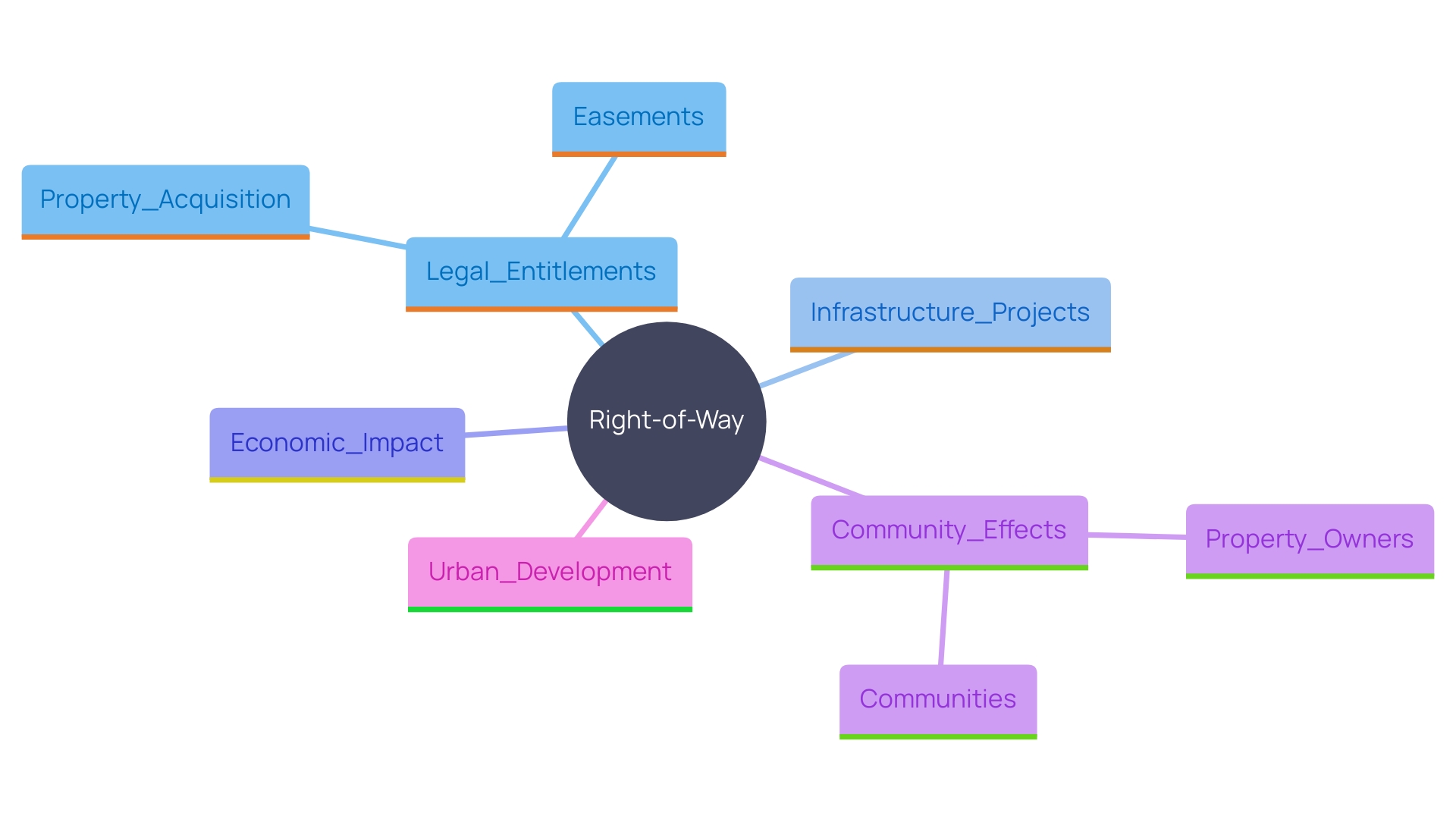
Types of Right-of-Way Acquisitions
Right-of-way acquisitions can occur through various methods, including voluntary agreements, negotiated purchases, and eminent domain. Each method carries distinct implications for property holders, influencing compensation, use rights, and the legal processes involved.
Voluntary agreements and negotiated purchases typically allow landowners to have more control over the terms of the transaction, potentially resulting in better compensation and more favorable conditions. However, these methods require both parties to reach a mutual agreement, which can sometimes be challenging. For instance, in September 2022, a three-judge panel for the Court of Appeals reviewed a case involving the 'centerline presumption,' a doctrine extending ownership to the middle of an adjacent right-of-way. This doctrine aims to prevent litigation over small parcels, highlighting the complexity and need for clear agreements.
Eminent domain, in contrast, is a formal procedure where the government can force the sale of private land for public use, usually at fair market value. This method is often used when voluntary agreements cannot be reached. The City of Fort Worth, for example, has authorized the use of eminent domain 29 times in the past two years to expedite road and pipe projects. This approach helps complete essential infrastructure developments but can be contentious due to its compulsory nature. Fort Worth's rapid growth, necessitating over $850 million in infrastructure investments over the past decade, underscores the critical role of eminent domain in urban planning.
Grasping these techniques and their consequences assists property owners in managing their choices efficiently, making certain they are more equipped to address possible judicial and financial results.
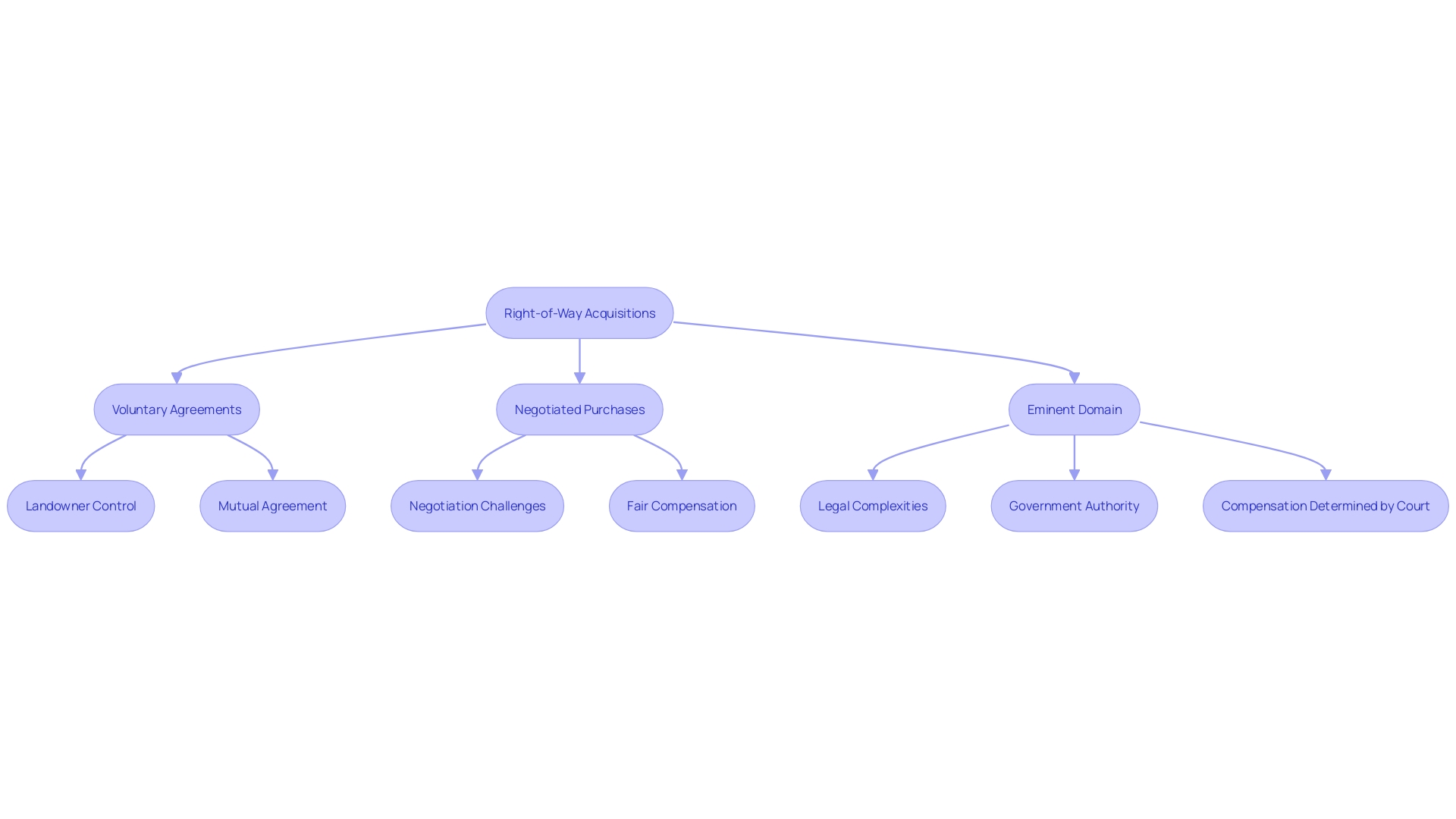
Legal Framework for Right-of-Way Acquisitions
The regulatory structure overseeing right-of-way acquisitions is complex, encompassing federal, state, and local laws. These regulations are pivotal in outlining the procedures for obtaining rights-of-way, defining the rights of landowners, and detailing the responsibilities of utility companies. Given the rapid growth in renewable energy projects, such as wind and solar installations, and the increasing need for transmission lines, understanding these laws has become more critical than ever. For instance, recent cases involving renewable energy projects have underscored the importance of clear legal guidelines to prevent disputes.
Federal laws, such as those outlined in the U.S. Constitution, ensure that any existing rights or benefits granted to landowners are preserved and not impaired by new amendments. State laws further elaborate on compensation procedures, emphasizing that private property should only be taken for public use, with the burden of proof resting on the condemning authority. Local regulations frequently tackle the particular needs and issues of nearby communities, ensuring that property holders' interests are protected.
In light of these regulations, property owners must remain vigilant and informed to protect their rights during right-of-way acquisitions. Recent news, such as the City of Chicago's lawsuit against major oil and gas companies, highlights the broader implications of regulatory compliance and the importance of transparency and fairness in these processes. Familiarity with these intricate legal frameworks is essential for property owners to navigate the complexities of right-of-way acquisitions effectively.
Eminent Domain and Right-of-Way
Eminent domain permits governmental entities to obtain private assets for public use, provided that fair compensation is paid to the owners. This process is frequently utilized for utility right-of-way acquisitions, which have become increasingly common with the rapid expansion of renewable energy projects such as wind, solar, and geothermal. For instance, the city of Fort Worth has employed eminent domain multiple times since 2020 to facilitate the Lake Arlington Lift Station project, addressing the growing infrastructure needs of the rapidly expanding city.
Understanding the eminent domain process is crucial for landowners, as it involves several key components, including the determination of public use, the appraisal process, and the negotiation of just compensation. Recent decisions and pending cases across the United States highlight the complexities and disputes that can arise from such projects. For example, in Wilmington, North Carolina, New Hanover County is attempting to seize a neighboring site to expand parking facilities for a new Government Center, demonstrating how eminent domain can be leveraged for various public needs.
The appraisal procedure, illustrated by a case from Freestone County, Texas, includes a group of landowners who evaluate the worth of the land being taken. This guarantees that those who own land receive just remuneration, although the right to take the asset itself is usually not disputed during this stage. The involvement of legal instruments such as compulsory unitization or pooling can also complicate negotiations, often resulting in compulsory rather than consensual agreements between property owners and acquiring entities.
As renewable energy development continues to surge, the demand for transmission lines to connect these projects to the power grid will likely increase, leading to more eminent domain cases. This trend highlights the importance for property owners to be well-informed about their rights and the mechanisms in place to ensure they receive just compensation when their property is acquired for public use.
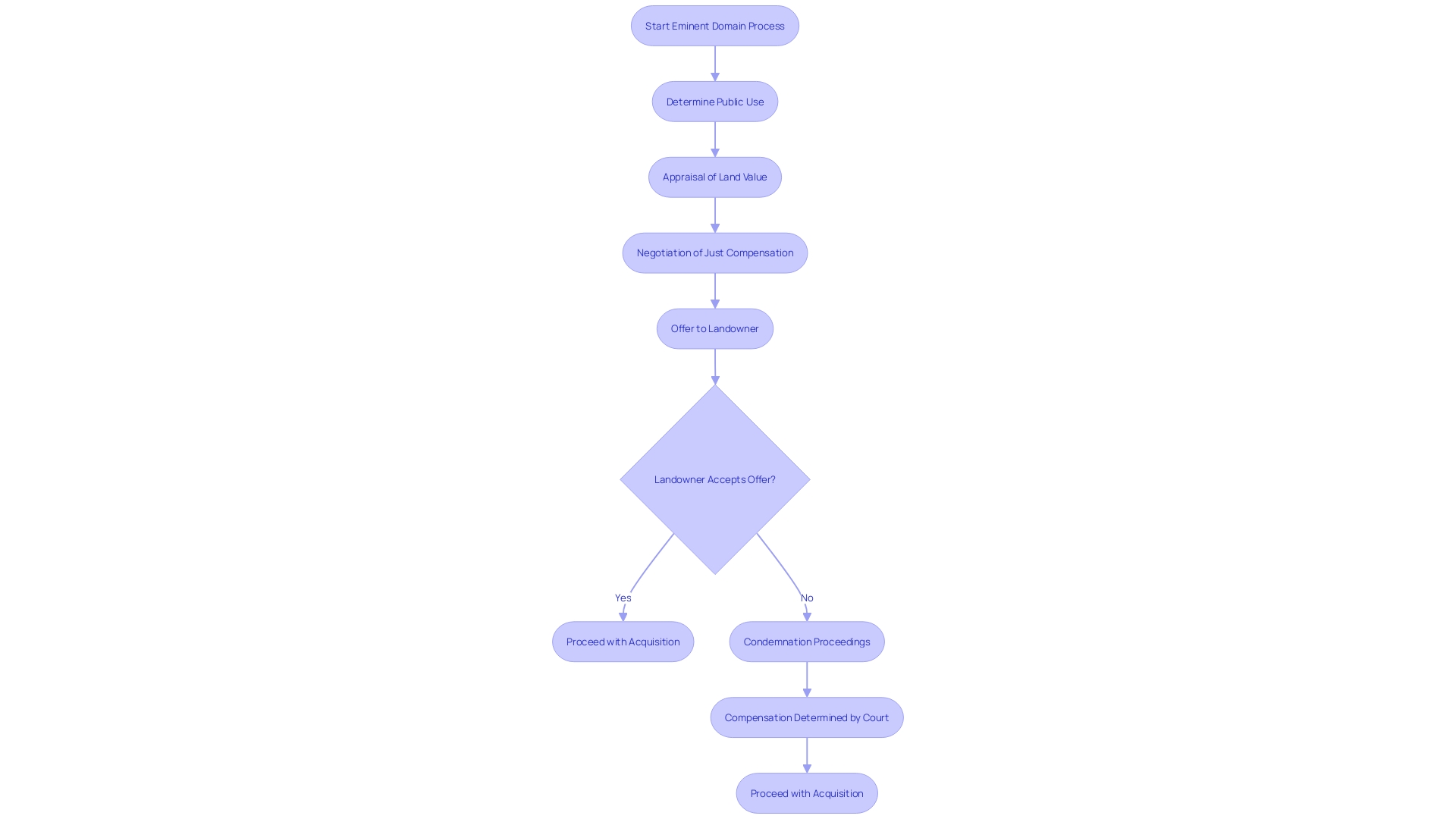
Best Practices for Right-of-Way Acquisitions
When dealing with right-of-way acquisitions, landowners should adopt several best practices to protect their interests effectively. One significant step is consulting attorneys who can navigate the complexities of land laws and regulations, ensuring that their rights are safeguarded. For instance, in a recent case, the Court of Appeals reviewed the 'centerline presumption' doctrine, which impacts land ownership extending to the middle of an adjacent right-of-way. Consulting a legal expert in such scenarios can clarify ownership issues and prevent potential conflicts.
Understanding the valuation process is also crucial. Landowners should be aware of how their land is assessed and ensure that the valuation reflects its true market value. In cases like the tentative agreement reached by the Town of West Seneca with residents over sewer easements, negotiating terms based on an accurate valuation can lead to more favorable outcomes. This proactive approach can help avert disputes and ensure fair compensation.
Moreover, negotiating terms that safeguard property owners' interests is essential. This includes securing agreements that provide adequate compensation and safeguard future property rights. The experience of Extraction Oil and Gas, Inc., which had to navigate complex ownership and royalty issues, underscores the importance of thorough and careful negotiation.
By being proactive and informed, property holders can achieve better results in right-of-way acquisitions, ensuring that their rights and interests are well protected.
Navigating Complexities in Right-of-Way Acquisitions
Gaining right-of-way for property development projects is a multifaceted endeavor, often entangled with regulatory and stakeholder complexities. Landowners find themselves navigating through conflicting interests, stringent environmental regulations, and community objections. For instance, the Town of West Seneca had to negotiate with residents to prevent a lawsuit over eminent domain procedures intended for sewer repairs, highlighting the contentious nature of such acquisitions. Moreover, regulations like the mercury rule and methane rule add another layer of complexity by imposing strict environmental standards that landowners must adhere to.
The judicial landscape also plays a critical role. 'The Court of Appeals' examination of the 'centerline presumption' doctrine in September 2022 demonstrated how interpretations can directly affect land ownership rights, extending ownership to the middle of an adjacent right-of-way to reduce disputes over small land parcels. This decision highlights the necessity for thorough examination during the acquisition process.
Strategies to address these challenges include fostering collaboration among private sector entities, government agencies, and local communities. This approach was exemplified by the Kunming-Montreal Global Biodiversity Framework, which emphasizes integrating environmental considerations into infrastructure projects. Similarly, the acquisition of Morrison Hershfield by Stantec is a testament to how strategic partnerships can enhance capabilities and streamline regulatory compliance.
Furthermore, a comprehensive understanding of judicial precedents, as demonstrated by the case involving Great Northern Properties and their subsurface mineral rights, is essential. These precedents can guide negotiations and help prevent prolonged disputes.
In conclusion, addressing the complexities of right-of-way acquisition requires a multifaceted strategy that incorporates legal insights, regulatory compliance, and stakeholder collaboration. This guarantees not only the successful acquisition of territory but also the sustainable and equitable development of infrastructure projects.
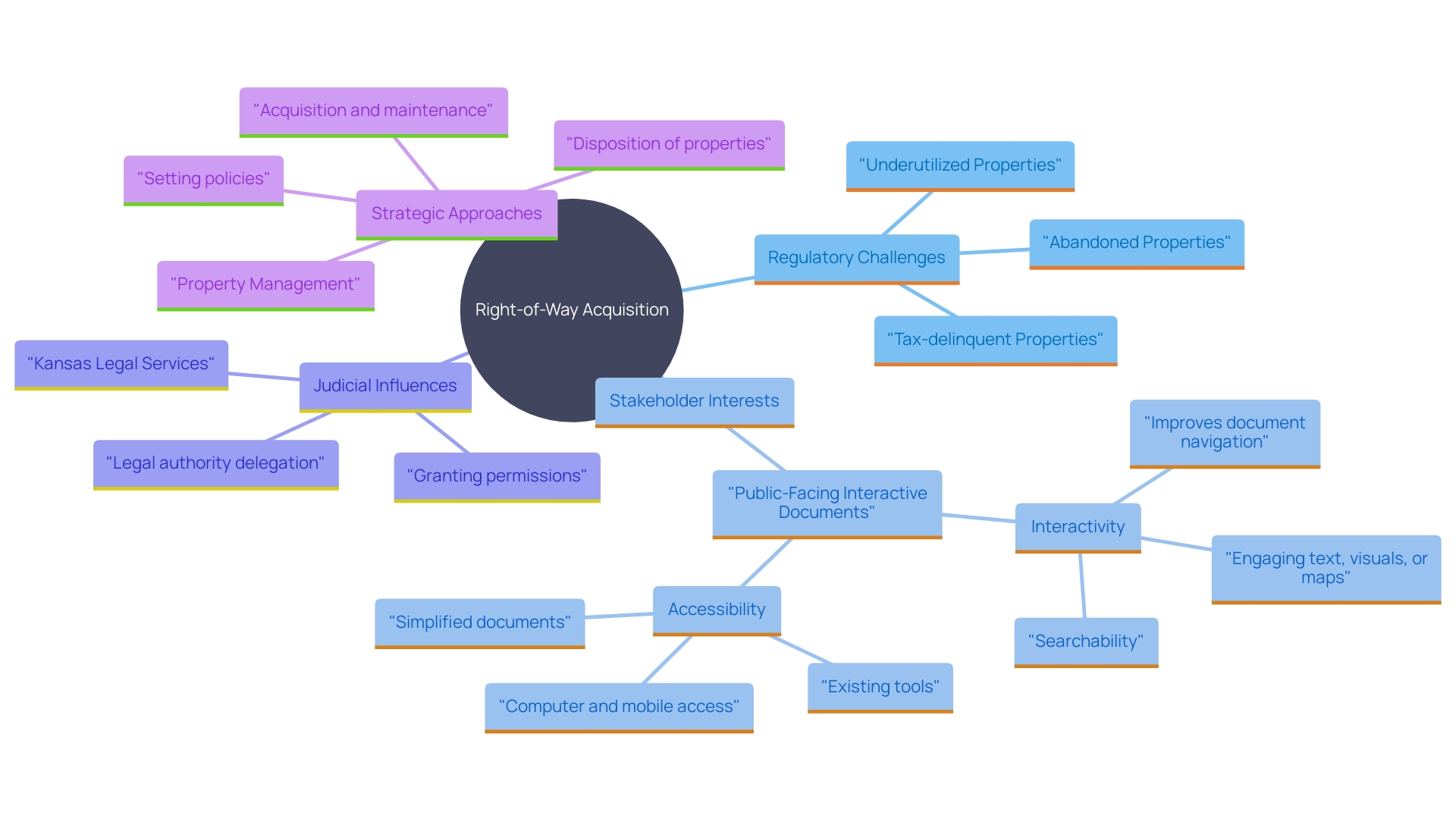
Role of Professionals in Right-of-Way Acquisitions
Experts such as property surveyors, real estate agents, and attorneys are essential to right-of-way acquisitions. Land surveyors offer vital services by accurately delineating land boundaries, which can avert conflicts and guarantee adherence to local zoning laws. For instance, over 95% of home buyers in the United States rely on property surveys before purchasing, highlighting their importance in establishing clear property lines and identifying any encroachments or easements that could affect land use. Real estate agents provide valuable market insights, helping property owners in navigating fluctuations and understanding the impact of licensing on labor supply, particularly as a 10% increase in housing prices correlates with a 4% rise in the number of agents. Attorneys play a crucial role in resolving legal issues and ensuring all transactions comply with current laws. Engaging these professionals can significantly enhance the effectiveness of a landowner's response to right-of-way proposals, making the process smoother and more efficient.
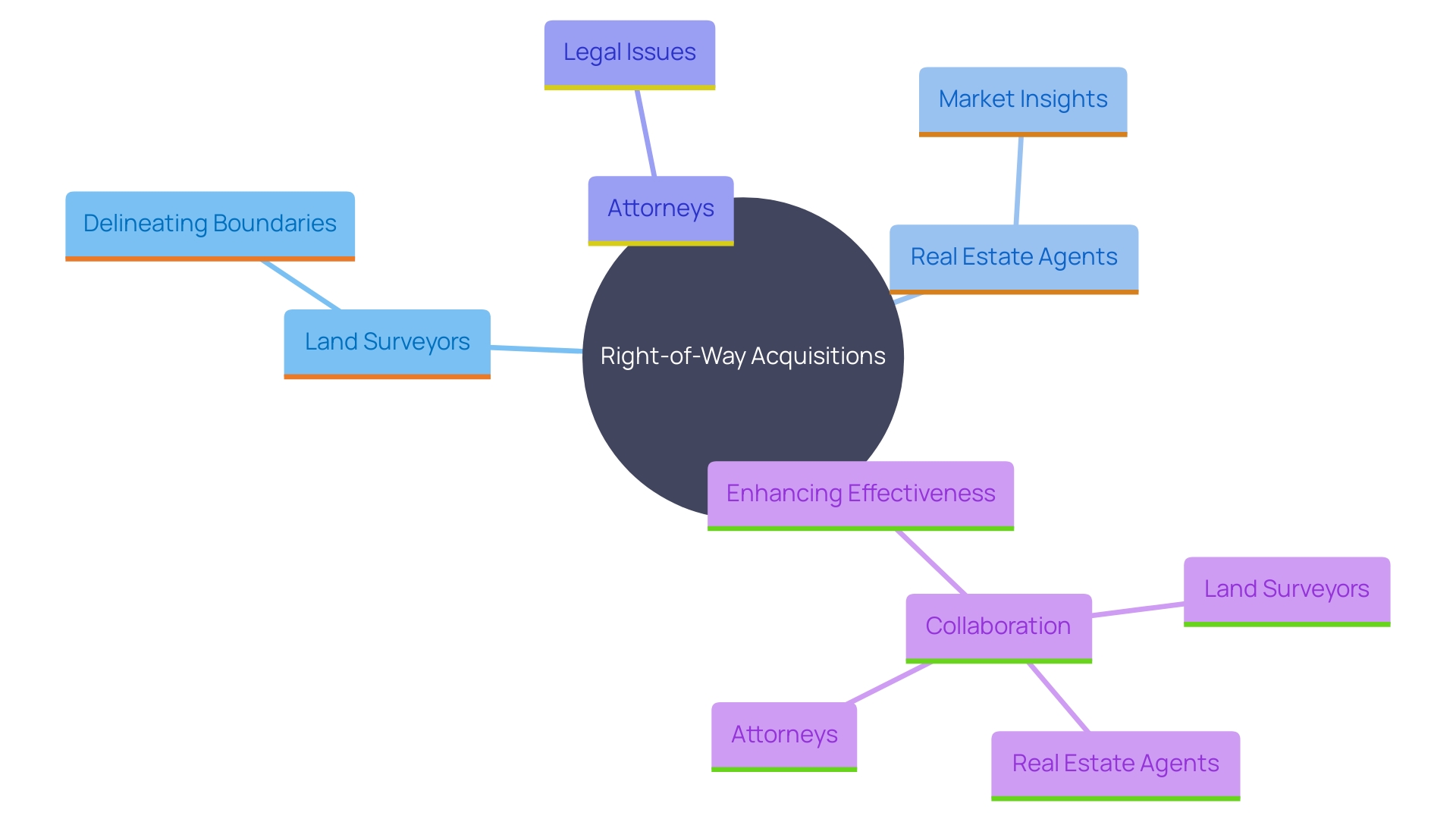
Conclusion
Understanding right-of-way is essential for landowners and stakeholders involved in land acquisition, as it dictates the legal right to use or traverse another's property. This concept is particularly significant in infrastructure development, evidenced by the City of Fort Worth's use of eminent domain for projects like the Lake Arlington Lift Station. The estimated $5.4 trillion value of land dedicated to roadways underscores the economic importance of these rights, while community protests, such as those by the Standing Rock Sioux Tribe, highlight their social implications.
Right-of-way acquisitions can occur through various methods, including voluntary agreements, negotiated purchases, and eminent domain, each with unique consequences for landowners. While voluntary agreements may offer better compensation, they require mutual consent, whereas eminent domain, though sometimes necessary for public projects, can lead to disputes over compensation and property rights.
The legal framework governing right-of-way is intricate, involving federal, state, and local regulations that landowners must navigate to protect their rights. Best practices include consulting legal experts, understanding property valuation, and negotiating favorable terms. Engaging professionals such as land surveyors, real estate agents, and attorneys can enhance the effectiveness of landowners' responses to right-of-way proposals.
By adopting proactive strategies and leveraging professional expertise, landowners can effectively navigate the complexities of right-of-way acquisitions, ensuring successful and equitable outcomes in infrastructure development.




